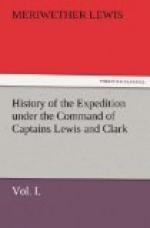The latitude of our camp below the entrance of Portage creek, was found to be 47 degrees 7’ 10” 3, as deduced from a meridian altitude of the sun’s lower limb taken with octant by back observation giving 53 degrees 10’.
Friday, June 21. Having made the necessary preparations for continuing our route, a part of the baggage was carried across the creek into the high plain, three miles in advance and placed on one of the carriages with truck wheels: the rest of the party was employed in drying meat and dressing elk skins. We killed several muledeer and an elk, and observed as usual vast quantities of buffaloe who came to drink at the river. For the first time on the Missouri we have seen near the falls a species of fishing duck, the body of which is brown and white, the wings white, and the head and upper part of the neck of a brick red, with a narrow beak, which seems to be of the same kind common in the Susquehanna, Potomac and James’ river. The little wood which this neighbourhood affords consists of the broad and narrow-leafed cottonwood, the box alder, the narrow and broad-leafed willow, the large or sweet willow, which was not common below Maria’s river, but which here attains the same size and has the same appearance as in the Atlantic states. The undergrowth consists of roses, gooseberries, currants, small honeysuckles, and the redwood, the inner part of which the engages or watermen are fond of smoking when mixed with tobacco.
Saturday, 22. We now set out to pass the portage and halted for dinner at eight miles distance near a little stream. The axletrees of our carriage, which had been made of an old mast, and the cottonwood tongues broke before we came there: but we renewed them with the timber of the sweet willow, which lasted till within half a mile of our intended camp, when the tongues gave way and we were obliged to take as much baggage as we could carry on our backs down to the river, where we formed an encampment in a small grove of timber opposite to the Whitebear islands. Here the banks on both sides of the river are handsome, level, and extensive; that near our camp is not more than two feet above the surface of the water. The river is about eight hundred yards wide just above these islands, ten feet deep in most places, and with a very gentle current. The plains however on this part of the river are not so fertile as those from the mouth of the Muscleshell and thence downwards;




